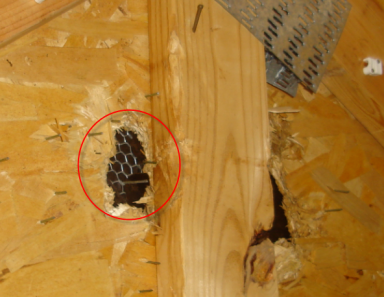 Battling the Effects of an Old Enemy - Stucco Underlayment Mesh Battling the Effects of an Old Enemy - Stucco Underlayment Mesh
On the west end of my attic space, the triangle shaped end cap contains an underlayment of stucco and wire mesh. See the mesh in the photo, left. This mesh acts somewhat as a lossy re-radiator of RF and couples to the antenna structure to a greater extent with increasing frequency. Because it's a permanent part of the structure, it falls into the "fixed and unchangeable" aspects of the antenna. And it was not until the current redesign of the 10m and 15m elements that I realized just how troublesome the stucco screen could be. I have considered modeling the mesh - but the actual underlayment mesh coverage - and how it's connected together with the rest of the stucco is unknown. In fact, just about everything about the RF characteristics of the stucco - as it would pertain to a close spaced HF antenna - is unknown. I suppose there is some way to characterize it but I don't know what that would be. So I've simply treated it as a given. From prior experience with the 40m phased 2-element build, I know that that the stucco does not function as a "shield" in the classic sense - signals do pass through the stucco. And if an antenna is built so that the current phase relationships are properly trimmed as indicated in the model, the antenna will be directional through the stucco. [This was again confirmed in the 10m rebuild as well.] Until recently the low bands up to 20m were the focus. But as the sunspot cycle has come back at long last the higher bands have taken center stage. And when building the 10m beam, I happened to think about the stucco - and having a wire dipole to relocate, I looked first at the west end location to determine the impact of the stucco wall on the placement. It provided to be quite a surprise. The test was done by moving a dipole along the center-line in increments of 22" (stud spacing) - taking care to keep the dipole in a plane parallel with the stucco wall. The drop in resistance at resonant frequency was amazing as the table below shows. Spacing from Stucco Wall | Resistance | 92" | 28 ohms | 70" | 17 ohms | 48" | 8 ohms |
Wow, I was shocked!!! And then a lot of prior memory's started to come back into focus... - The 6m 3-element was impossible to trim unless it was on the east end of the attic.
- The 15m west element never would trim properly
- The 20m west element was very sensitive to tuning
- The 30m and 40m west side elements always read at a lower resistance value that it's east counterpart.
And based on the dipole vs. spacing test result, the trend becomes obvious. As frequency increases, the interaction between the stucco and the element is increased as well. Unfortunately, there is not much to be done about this in an ideal sense. However, we can space the antenna as far away from the stucco wall as possible. And by a change of design from a 3-element type to a 2-element type improves things as well. A 2-element design, based on a director + DE, can be constructed from the existing 3-element yagi's, by simply omitting the reflector loading coil - leaving the reflector element open. This means the 2-element east beaming direction will be spaced as far as possible away from the stucco wall. 2-element beams are easier to trim as well - at some trade off in bandwidth and feed point resistance. But that's not much of a compromise if the reflector is being swamped by the stucco! These were the context and consideration for which the various beam rebuilds were based on. |